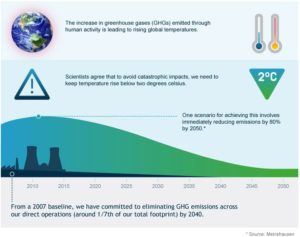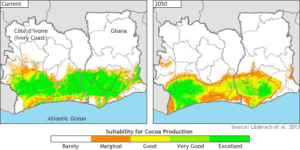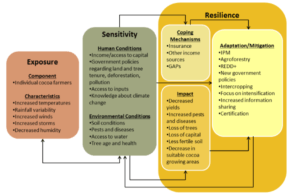In Love with the Cocoa – How Mars Inc. is Leading the Way in Addressing Climate Change

Mars Inc. is committed to being part of the solution when it comes to cutting emissions and fighting climate change. How are they doing it?
Mars Inc. (Mars) is on the forefront in the food processing industry in proactively combatting climate change and the effects it can have on a company’s business model. Mars’ primary raw material is cocoa, which grows best in the rainforest under specific conditions including uniform temperatures (within ~20 degrees of the equator), high humidity, abundant rain, and low to non-existent wind levels. Most of the world’s cocoa is sourced from West Africa, Southeast Asia, and the Americas. In recent years, research suggests that rising temperatures have a direct impact on rates of rainfall and evaporation1, leading to an increase in evapotranspiration, or the sum of evaporation and plant transpiration from the Earth’s land to the atmosphere. This increase, more so than the increase in temperature, threatens the future sustainability of cocoa since projected temperatures in West Africa by 2050 are unlikely to be accompanied by a sufficient increase in rainfall to offset the moisture loss, according to projected carbon dioxide emissions scenarios2.
In addition, climate change will cause cocoa-growing locations, located within 300 km of the coast, to shrink by 20302. By 2050, rising temperatures will push the suitable cacao cultivation areas uphill, as the optimal altitude will rise by over 1,000 feet, and force growing countries to “choose between growing enough to meet demand and preserving natural habitat2”.
Source: Climate and Chocolate2
In order to address these issues, Mars has taken a multi-pronged approach including partnering with non-profits, targeting emission reduction benchmarks, and employing in-house meteorologists. These meteorologists are dedicated to analyzing the impacts of weather on the cocoa-producing business in order to anticipate necessary changes in the supply chain to promote more sustainable future cocoa supply3.
Mars has set targets to reduce its emissions through the company’s Sustainable in a Generation program, vowing to eliminate all greenhouse gas emissions from operations by 2040 and reduce emissions from product deliveries to retail customers as much as possible4. In 2015, Mars met its goal to cut greenhouse gas emissions by 25% in large part to the company’s new wind  farm in Texas, which allowed Mars to cut Scope 2 emissions (greenhouse emissions from consumption of purchased electricity, heat, or steam) by nearly 40%. This 200 megawatt wind farm has 118 turbines producing enough electricity to power over 60,000 homes, or all of the company’s domestic sites, making Mars the first major food business to source all of its electricity for its domestic operations from renewable sources. While it did not hit its target of decreasing fossil fuels by 25% in 2015, the company has reduced total energy use by 5% and fossil fuel use by 18% since 2007, while simultaneously growing the business4.
farm in Texas, which allowed Mars to cut Scope 2 emissions (greenhouse emissions from consumption of purchased electricity, heat, or steam) by nearly 40%. This 200 megawatt wind farm has 118 turbines producing enough electricity to power over 60,000 homes, or all of the company’s domestic sites, making Mars the first major food business to source all of its electricity for its domestic operations from renewable sources. While it did not hit its target of decreasing fossil fuels by 25% in 2015, the company has reduced total energy use by 5% and fossil fuel use by 18% since 2007, while simultaneously growing the business4.
MARS has employed several new strategies in order to reduce these emissions and promote efficiency throughout the company. For example, a team in the U.K. has come up with several of energy-saving projects, ranging from switching off lights in unoccupied areas to optimizing the building management system, which have saved the business ~1,000 kilowatt-hours per week4. Additionally, the team in Belgium has invested $500,000 in a pilot project to research new technologies in hopes of cutting greenhouse emissions by 50%.
While management is committed to fully eliminating scope one and two emissions by 2040, ~77% of the company’s scope three emissions (from purchased raw materials, transportation, packaging and other goods and services) relate to the production of the purchased goods and services, in particular agricultural raw materials. The agricultural materials release these greenhouse emissions through energy used during farming and the production of fertilizers and pesticides, nitrous oxide from livestock and crops, and forest clearance. The company is continually working with scientific experts at the Sustainable Agriculture Initiative Platform and the University of Cambridge to explore ways to reduce emissions by developing a better strategy for encouraging sustainable agriculture in the supply chain4.
Source: Assessment of Climate Change Impacts on Cocoa Production and Approaches to Adaptation and Mitigation5
It is important to note that there is time for Mars and other cocoa-consuming companies to adapt their practices since the changes in climate suitability are expected to take place over the next 40 years, impacting the next generation of cocoa farmers more than the current one. In addition to the steps that company has outlined, management should consider promoting change in the cultivation process to retain, or in some cases replant, other rainforest trees. These taller retained or replanted trees would provide cacao trees with shade, that could help decrease both temperature and evapotranspiration, as well as protection from wind and soil erosion. Additionally, carbon that would have been released into the atmosphere as a result of clearing these trees from the forest would no longer be released2. By methodically addressing the company’s supply chain issues through alternative energy programs, increased efficiency, and partnerships with researchers and sustainability experts, management has put Mars on a path to eliminate greenhouse gas emissions from operations by 2040.
(798 words)
Sources:
1 Climate Change in 2016: Implications for Business case
2 https://www.climate.gov/news-features/climate-and/climate-chocolate
4 http://www.mars.com/global/sustainability/operations/energy-climate
5 https://elliott.gwu.edu/sites/elliott.gwu.edu/files/World%20Cocoa%20Foundation.pdf





Your suggestion of retaining / replanting other rain forest trees sounds innovative. I like this idea because it will be intuitively less complicated to understand, potentially helping earning buy-in from a broad range of producers (in reality, intuition could work as a stronger persuader than logic). Also, you raised an important point: the changes in climate sustainability are expected to happen in a long period of time. I believe that this nature creates a leadership challenge – how to keep stakeholders motivated and delivering the results when there is relatively low time pressure. Especially because Mars will, at a certain point, face a decision of involving raw material producers (whom I assume are a large number of stakeholders) to tackle with the large chunk of emission, making organizational momentum regarding this topic “sustainable” would be essential for Mars to keep leading the industry for sustainability issues.
As Satoshi highlighted, I think its a great idea to think about changes in the actual cultivation process. Mars focus seems to be too limited on reducing emissions, which will only change the situation in long-term. In short-term, they should try to plant additional trees in existing areas, find suitable alternative spots to grow the trees (might be now possible due to the climate change), and consider greenhouse growing areas to be independent of the climate.
Totally resonate with the idea. Cocoa is the most critical raw material and the one with most volatile supply for chocolate manufacturer. Climate change is only going to increase the volatility by adding environmental factors. The player who gains advantages in cocoa supply will have “strategic” long term advantage in the market. When I was visiting Mars’ plantation in Indonesia and observed cocoa production process, I realized how complicated the process was and how little those farmers were earning. Young people in those rural areas were not incentivized to take cocoa production as their jobs. That also contributed to the risk of cocoa supply shortage in the long term. So In Mars SIG project, another very important piece to ensure sustainable cocoa supply in the long term is to improve the welfare of cocoa farmers, such as fair pay and good working conditions, along with training on new and more productive technology for farmers to ensure quality labor input for cocoa production.
Thanks for this post, Matt! I was intrigued by your idea to replant trees in the forests to strengthen the canopy and provide more shade in warming regions. This also improves the biodiversity of the plots. http://www.cargill.com/corporate-responsibility/responsible-supply-chains/cocoa/index.jsp
While I think that could be an effective idea, I would advocate for replacing the actual cocoa trees first, as a disproportionate number of cocoa trees are aging and becoming less productive. In the above link, Cargill notes they are working on a replanting effort to transition older trees out of production. Since it can take up to 5 years for a cocoa tree to yield any output, farmers often forgo replanting and rely on increasingly aging trees, which is a poor business model since yield declines rapidly as a tree approaches the end of its life. https://www.devex.com/news/can-ghana-s-cocoa-farmers-ever-emerge-from-poverty-83883. I would encourage Mars to invest in a similar strategy as Cargill, and explore replanting both cocoa trees and shade trees.
I completely agree with your advice to Mars. A lot of companies, like Mars, are only addressing climate change with half measures such as making their buildings and infrastructure more eco-friendly and energy-efficient. In particular, I’m really concerned about the water scarcity issue that climate change presents, which would severely impact cocoa plants (http://www.fao.org/docrep/006/ad220e/ad220e03.htm), and which energy-efficient buildings can’t even begin to address. That’s why I like your idea of innovating the cocoa agricultural process and trying to preserve the water/soil levels.
Thanks for the post and appreciate the tables and diagrams that you included. It sounds like Mars is making the right moves to focus on cutting emissions related to the supply of the cocoa. I think the replanting idea sounds very interesting, particularly if they could balance the consumption with the growth. Further, the increasing the efficiency of their consumption processes also seems like a valuable approach and seems like it would have increased short term positive impacts. I’m curious whether they have done anything else to make their output and production side more efficient as well.
Matt thanks for writing this article. I have been involved in the cocoa processing business in Indonesia – one of top 3 global producers. We have been seeing more intense fluctuations in cocoa prices in recent years because as you said these are weather-sensitive crops. In recent years, Indonesia’s supply of cocoa is insufficient to meet processing capacity so it has had to import from Africa – bad news for last wave investors like Cargill and Barry.
http://m.bakingbusiness.com/articles/news_home/International/2014/05/Cocoa_companies_invest_in_Indo.aspx?ID=%7B61E5C33D-6CDA-4B53-B851-37A3B785E69D%7D&cck=1
Happy to meet up to talk guys!
Hi Matt! Thanks for sharing – great write-up! Sustainability through the company’s supply chain, including through sustainable agriculture like you have identified, is key to driving a truly “green” product. Perhaps Mars should also explore the potential to invest in research and development efforts to develop lab-grown, sustainable, cocoa substitutes to supplement its agricultural procurement. This will ensure a dependable, sustainable, and potentially more cost effective supply of raw cocoa for the company going forward.